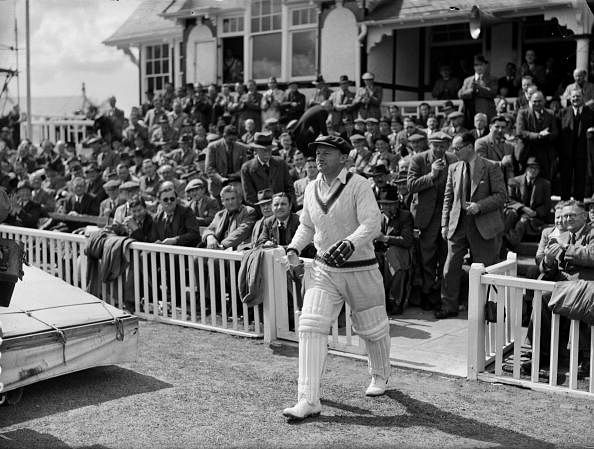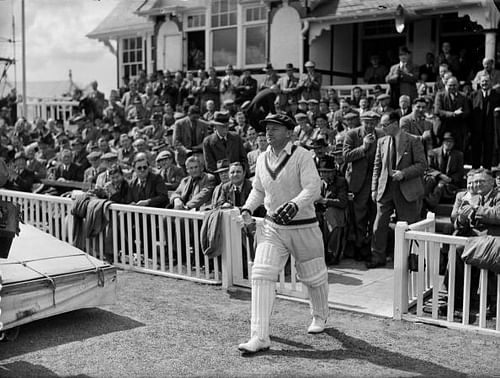
The Ashes legends: The one above all - Sir Donald Bradman

Sir Don Bradman
Bring up the Ashes and its famous players and a number of names will come to mind, such as Harold Larwood, Fred Spofforth, Ian Botham or Dennis Lillee. Arguably the most famous of them all, however, is Sir Donald Bradman.
From disappointing beginnings in the series of 1928-29 to captaining the Invincibles in England in 1948, inspiring in the face of notorious bowling of the Bodyline series and still dividing fans today, Bradman is one of the most well known names in the history of Ashes cricket and, indeed, the history of cricket in general.
Having played his first season for NSW in the 1927-28 season, Bradman came the attention of the Australian selectors the following season, an Ashes summer in which he scored prolifically in the Sheffield Shield. He was called up to play in a tour match against the England side at a new ground in Brisbane called the Gabba and made 87 and 132, a performance that earned him a spot in the team for the first Ashes Test.
Australia lost that first Test by a huge margin and, after scoring just 18 and 1, Bradman was dropped for the second Test at Sydney, although he was used as a substitute fielder after Bill Ponsford fractured his hand. He was recalled for the third Test at Melbourne and made 79 and 112 and then made another century in the fifth Test, also at Melbourne, helping Australia to their only win of the series.
After such a beginning to his international career, Bradman was becoming known in Australia, but it would be the return tour to England in 1930 that catapulted him onto the world stage.
The 1930 Ashes tour turned things around for Australian cricket, which had had some problems, and made the Ashes almost entirely their own right through to the 1950s.
On the 1930 tour to England, Bradman announced his arrival in a match against Worcestershire, helping himself to 236 runs. From there, he went on to hit a number of milestones during the series, including the first century by an Australian at Nottingham; the highest ever innings by an Australian at Lord’s and the fastest double century (in terms of minutes) in the history of Test cricket at Headingley, en route to the infamous 334.
Australia won the series and the England side were in disarray. They would have to tour Australia in the Antipodeans’ summer of 1932-33 and face this machine of a man yet again. They needed a plan; they came up withbodyline.
Bodyline may or not have been designed deliberately to injure batters or to curb the effectiveness of just Bradman, but there is little doubt it was born out of the England failure in the 1930 Ashes and honed specifically for the return tour. Australia had developed an enviable batting line up by 1932, which consisted of much more than just one man, and this new style of bowling was designed to intimidate them and, hopefully, remove them quickly.
Controversial as the leg theory or ‘Bodyline’ was, and it certainly caused a furore with the Australian public, it seemed to do the trick and England regained the Ashes, winning all but one of the five Tests.
Bradman did not play the first Test and in the second got his first ever duck against England in the first innings. In the second innings however, he got back into his own with a century. His run scoring throughout the series was not as free as in 1930, but it was certainly not disappointing, as he made over 70 in both the fourth and fifth Tests and 66 in the third.
After the excitement of the previous two Ashes series, the 1934 series in England and the 1935-37 series in Australia tend to be forgotten. For Bradman, however, they were equally good. In 1934 he got another triple century at Leeds and 244 at the Oval. In a tour match against the England XI at Folkestone in Kent, he became the first batsman in first class cricket to get 30 runs off one six ball over.
The 1936-37 series was Bradman’s first as captain of the Australian side and he began the series with a duck in both the first and second Tests. In the third and fourth Tests, though, he got double centuries and then 169 in the fifth. His total for the series was 810 runs, which was a record for a captain in a Test series.
In 1938, Bradman once again captained the Australians on a tour to England. This would be the last Ashes series for eight years, as the rivalry was interrupted by a much tougher test in which the Australians and Englishmen would have to fight side by side.
The series began with Bradman taking a double century in the tour match against Worcestershire, something that was almost a tradition with him having gotten 206 in the same fixture in 1934 and 236 in 1930. He got another century in the first Test at Trent Bridge, reaching a record 13 centuries against England, and centuries at both Lord’s and Headingley. Although he can’t take credit for the record personally, Bradman’s century at Lord’s was the 200th in Tests between Australia and England.